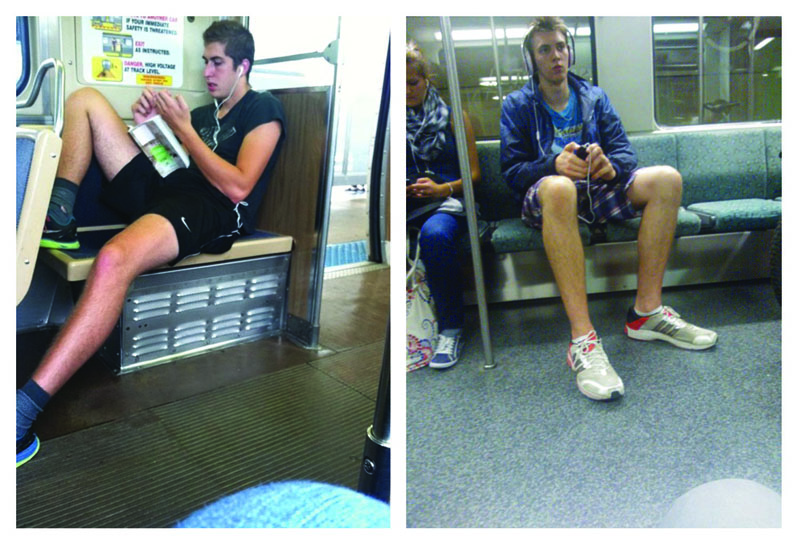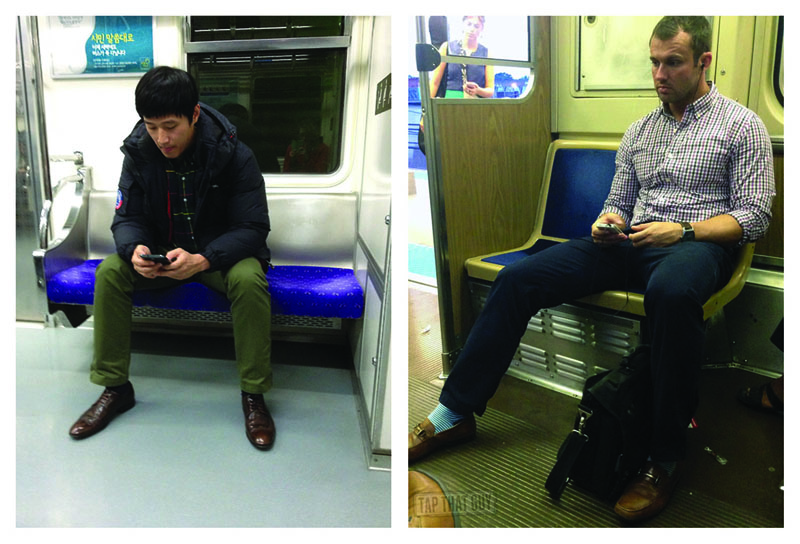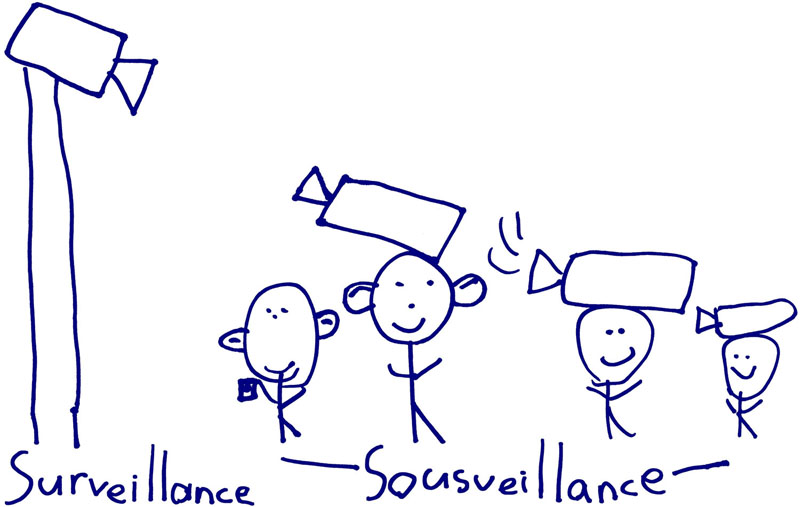#Submissions, Surveillance, and The Mobile Gaze by Amelia Acker
|
A new Tumblr has made the rounds called, “MEN TAKING UP 2 MUCH SPACE ON THE TRAIN.” The site features photograph submissions of men with their legs spread, usually sitting on more than one train seat, using plenty of legroom in the aisle. The subjects are usually looking at their phones, sometimes reading or staring off vacantly. A few photos are of men sleeping, laying horizontally across whole rows of seats. The photographs appear to be taken with camera phones, without the subject’s knowledge and submitted directly through the Tumblr site’s submission link. Tumblr‘s web platform and mobile app provide an easy way for bloggers to receive and post anonymous submissions from contributors, amongst other tools for quick publishing. The submission tool has proven influential for sharing and posting on Tumblr, and open submissions drive a variety of themed blogs. The anonymous submission tool also bolsters a relatively new affordance for capturing what you see in public with your camera phone and sharing it with a networked audience. Given the coverage that MEN TAKING UP 2 MUCH SPACE received on feminist news sites, the Tumblr appears to resonate with women commuters who daily witness dudes exhibiting the privilege of taking up space in public seating areas. But we shouldn’t rule out the possibility that men with camera phones submit just as many photos. There’s another genre of photo submission Tumblrs, which I will loosely refer to here as “cute boy tumblrs” that occasionally feature anonymous photos of men in public: waiting in line at jamba juice, working out at the gym, hanging out at the park, and sometimes riding public transportation. The basic idea of cute boy tumblrs is to share images of dudes that range from print ads, to selfies, to screen grabs from TV. Sites like You Are An Object, Daily Cute Boy, and Boygaga are billed as Tumblrs for users to create, consume, and share a visual culture of hot guys. One in particular, TAP THAT GUY features anonymous camera phone submissions similar to MEN TAKING UP 2 MUCH SPACE. Both include hashtags, which label the transportation line or the location where the photograph was taken, and both sites encourage anonymous submissions from readers. Many of the posts on TAP THAT GUY and MEN TAKING UP 2 MUCH SPACE appear to be interchangeable.* TAP THAT GUY has a tagline that explains the process: “You take it. We share it. Candid photos of hot guys from around the world, taken by you, updated frequently.” Both Tumblrs look and feel very similar despite different motivations for submissions. TAP THAT GUY and MEN TAKING UP 2 MUCH SPACE share many of the same conventions for submitters and as they do for the audiences. The composition similarities between both sites and the anonymous submissions they publish are striking. Even the desire and willingness to contribute to each Tumblr appear connected: someone sees a guy in a public space, knowing that a photo of him will have some purchase with an audience, they snap a photograph, tag it and submit. The implicit level of on-the-ground surveillance that both sites encourage through the Tumblr submission tool, and by extension through our mobile phones, enables what I want to call “the mobile gaze”. While a visual connection between these two submission sites may seem obvious to the casual observer, there are even more connections through the mobile gaze that an Internet-connected camera phone provides. The mobility of this gaze creates a new kind of infrastructure for surveillance. Consider how these anonymous camera phone submissions are used as tools to regulate which bodies matter where, in what public spaces, and at particular times. The mobile gaze gives us an opportunity to examine who gets to see, document and circulate these records of bodies moving in public space as well. Bodies that look and capture what they see have the power of surveillance when they use their mobile phone. This power is transformed with an Internet connected camera phone and the possibility for anonymous submission to a social media platform with a mobile app. And further, ideas about whether a body is hot enough to tap, or if bodies are taking up too much space, are built upon the consumption of surveillance infrastructure. Our ability to see through a mobile gaze has shifted too with access to publishing platforms like Tumblr. The desire to capture, share, and submit what one sees becomes co-constituted by a mobile phone with recording and wireless data transmission capabilities. I also want to argue that both TAP THAT GUY and MEN TAKING UP 2 MUCH SPACE feature photographs of bodies in public, and moving in transit is not a coincidence. If modern tools of surveillance are known to us as constant and unwavering in public spaces, and more recently in all of our online tools and mobile devices, it is with the mobile gaze and new practices of capture and submit that change traditional surveillance expectations by subverting desire and the possibilities of seeing (and recording) as we move. Submission photos create a kind of twinning of surveillance: where on one hand the Tumblr user is aware of an implicit understanding that public space is always already under surveillance given that mobile phone data is enrolled in state surveillance programs and corporate big data research, and on the other hand, mobile network coverage provides users with participatory tools of surveillance (or “sousveillance”). The act of taking camera phone photos in public for anonymous submission also speaks to the materialites of the body performing such acts of participatory surveillance. The gaze becomes a way to regulate which bodies matter and when, but it also relies on the ability to see and the intent to record and share. At times, there are bodies that experience surveillance as empowering, and historically these people have been mostly white, straight men. The mobile gaze that enables surveillance relies on a kind of power that has been (relatively) recently afforded to new observers, or rather, nontraditional surveillers (like gays, women, students, activists) since the rise of mobile phones with cameras in the early 2000s. The power of this gaze is not independent of a seeing, surveilling body carrying a mobile device connected to a wireless network. To the active Tumblr user, we can see that most submissions on both sites appear to be surreptitiously captured. The body of the witness (and surveiller), whose gaze locates other bodies taking up too much space or bodies so hot we’d like to tap—this seeing body carries a phone, takes photos, tags and submits them to a platform that publishes them for an audience. Tumblr submission photos then act as gateways with more than one entry and exit point for examining infrastructures of surveillance and privilege. As gateways, they reveal directions of surveillance directed inwards towards users (by service providers, manufactures, and governments) and outwards by allowing users themselves to document bodies in space, bodies that matter whether they are out of line or evoke desire. Despite the motivations for submission, many anonymous photos locate bodies in public spaces, and perhaps more importantly their mobility through those spaces. The tagline for MEN TAKING UP 2 MUCH SPACE is, “a classic among public assertions of privilege.” The tagline cue’s the audience in to the motivations for submission as well as the reception of the photos. If the mobile gaze supplants traditional expectations of surveillance, then public space, or the experience of being and moving through it may shift as well. Submission themed Tumblrs that exhibit the mobile gaze expose people to the notion that constant visibility and control through surveillance in public space is in part accomplished with our mobile phones. It may not be very long before submission photos like these become a new kind of public assertion of privilege.
[1] Since the #submission of this piece in December 2013, MOVE THE FUCK OVER, BRO has also risen to Tumblr prominence. |


